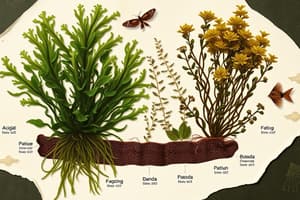Podcast
Questions and Answers
Which kingdom contains prokaryotic algae?
Which kingdom contains prokaryotic algae?
- Fungi
- Monera (correct)
- Protista
- Eukarya
What class is associated with the division Chrysophyta?
What class is associated with the division Chrysophyta?
- Charophyceae
- Heterogenerate
- Xanthophyceae (correct)
- Euglenophyceae
What pigment is found in Rhodophyceae and Cyanophyceae?
What pigment is found in Rhodophyceae and Cyanophyceae?
- Chlorophyll a
- Phycocyanin
- Phycoerythrin (correct)
- Carotenoids
Which of the following amino acid characteristics describes Euglenoids?
Which of the following amino acid characteristics describes Euglenoids?
Which algae have chlorophyll a, b, and carotenoids as pigments?
Which algae have chlorophyll a, b, and carotenoids as pigments?
What class belongs to the division Phaeophyta?
What class belongs to the division Phaeophyta?
Which division of algae is classified under the kingdom Protista?
Which division of algae is classified under the kingdom Protista?
What type of algae were previously classified in both plant and animal kingdoms?
What type of algae were previously classified in both plant and animal kingdoms?
What is a common characteristic of green algae that links them to plants?
What is a common characteristic of green algae that links them to plants?
Which of the following is a type of green algae that is unicellular?
Which of the following is a type of green algae that is unicellular?
What is the primary reserve food material found in Xanthophyceae?
What is the primary reserve food material found in Xanthophyceae?
Which substance is NOT commonly derived from marine algae?
Which substance is NOT commonly derived from marine algae?
What distinguishes Vaucheria in terms of its structure?
What distinguishes Vaucheria in terms of its structure?
What feature is characteristic of the cell wall of Vaucheria?
What feature is characteristic of the cell wall of Vaucheria?
What is the ecological role of algae in aquatic ecosystems?
What is the ecological role of algae in aquatic ecosystems?
Which type of algae is commonly referred to as golden-brown algae?
Which type of algae is commonly referred to as golden-brown algae?
Which feature distinguishes algae from true plants?
Which feature distinguishes algae from true plants?
What is the primary method by which most algae obtain their energy?
What is the primary method by which most algae obtain their energy?
What type of algae is included in the Chrysophyta group?
What type of algae is included in the Chrysophyta group?
In which habitat can algae be found?
In which habitat can algae be found?
Which of the following statements about algal reproduction is correct?
Which of the following statements about algal reproduction is correct?
Which characteristic is true of freshwater algae?
Which characteristic is true of freshwater algae?
What do algae primarily lack that differentiates them from vascular plants?
What do algae primarily lack that differentiates them from vascular plants?
Which of the following is NOT a type of attachment for algae?
Which of the following is NOT a type of attachment for algae?
Which pigments are found in dinoflagellates?
Which pigments are found in dinoflagellates?
What characteristic is NOT true for chirosiphonous algae?
What characteristic is NOT true for chirosiphonous algae?
Which algae is noted for being non-motile and primarily attached to rocks?
Which algae is noted for being non-motile and primarily attached to rocks?
Which of the following algae is known for forming toxic red tides?
Which of the following algae is known for forming toxic red tides?
What is the primary function of diatoms in aquatic ecosystems?
What is the primary function of diatoms in aquatic ecosystems?
Which type of algal cell wall consists of two overlapping shells made of silica?
Which type of algal cell wall consists of two overlapping shells made of silica?
Which group of algae is primarily characterized by a differentiated structure such as blades and holdfasts?
Which group of algae is primarily characterized by a differentiated structure such as blades and holdfasts?
Which pigments are NOT found in brown algae?
Which pigments are NOT found in brown algae?
Flashcards
Algae
Algae
A group of photosynthetic organisms, either prokaryotic (cyanobacteria) or eukaryotic, carrying out a significant portion of Earth's photosynthesis.
Eukaryotic Algae
Eukaryotic Algae
Eukaryotic algae include various types like Euglenophyta, Dinoflagellates, Chrysophyta(diatoms), Rhodophyta(red algae), Phaeophyta(brown algae), and Chlorophyta(green algae).
Planktonic Algae
Planktonic Algae
Free-floating algae in aquatic environments.
Attached Algae
Attached Algae
Signup and view all the flashcards
Thallus
Thallus
Signup and view all the flashcards
Unicellular Algae
Unicellular Algae
Signup and view all the flashcards
Filamentous Algae
Filamentous Algae
Signup and view all the flashcards
Coenocyte
Coenocyte
Signup and view all the flashcards
Algal Habitat
Algal Habitat
Signup and view all the flashcards
Epiphytic
Epiphytic
Signup and view all the flashcards
Epiphyte
Epiphyte
Signup and view all the flashcards
Euglena Structure
Euglena Structure
Signup and view all the flashcards
Dinoflagellate Cell Wall
Dinoflagellate Cell Wall
Signup and view all the flashcards
Dinoflagellate Pigments
Dinoflagellate Pigments
Signup and view all the flashcards
Diatom Structure
Diatom Structure
Signup and view all the flashcards
Brown Algae Form
Brown Algae Form
Signup and view all the flashcards
Brown Algae Pigments
Brown Algae Pigments
Signup and view all the flashcards
Red Algae Characteristics
Red Algae Characteristics
Signup and view all the flashcards
Green Algae Forms
Green Algae Forms
Signup and view all the flashcards
Green Algae Pigments
Green Algae Pigments
Signup and view all the flashcards
Algal Classification
Algal Classification
Signup and view all the flashcards
Cyanophyta
Cyanophyta
Signup and view all the flashcards
Chlorophyta
Chlorophyta
Signup and view all the flashcards
Euglenophyta
Euglenophyta
Signup and view all the flashcards
Pigment Composition
Pigment Composition
Signup and view all the flashcards
Phycobilins
Phycobilins
Signup and view all the flashcards
Euglenoids
Euglenoids
Signup and view all the flashcards
Protista
Protista
Signup and view all the flashcards
Heterotrophic
Heterotrophic
Signup and view all the flashcards
Photosynthetic
Photosynthetic
Signup and view all the flashcards
Green Algae
Green Algae
Signup and view all the flashcards
Green Algae Examples
Green Algae Examples
Signup and view all the flashcards
Algae Importance
Algae Importance
Signup and view all the flashcards
Golden-brown Algae (Chrysophyta)
Golden-brown Algae (Chrysophyta)
Signup and view all the flashcards
Xanthophyceae
Xanthophyceae
Signup and view all the flashcards
Vaucheria
Vaucheria
Signup and view all the flashcards
Vaucheria Thallus
Vaucheria Thallus
Signup and view all the flashcards
Study Notes
Introduction to Phycology (Algae)
- Algae are photosynthetic organisms
- They carry out 50-60% of Earth's photosynthesis
- They use sunlight and chlorophyll to create food
- Range from microscopic single-celled organisms to large seaweed
- Most are aquatic, found in oceans, freshwater, ponds, lakes, streams, hot springs, polar ice, moist soil, trees, and rocks.
- Algae are non-vascular, primitive plants lacking roots, stems, and leaves.
- They reproduce both sexually and asexually using spores, rather than seeds.
Eukaryotes - Algae
- Euglenophyta
- Dinoflagellates
- Chrysophyta (EX. Vaucheria sp)
- Rhodophyta (Red Algae)
- Phaeophyta (Brown Algae)
- Chlorophyta (Green Algae; EX: Chlamydomona + Volvox sp. + Spirogyra sp)
- Importance of Algae
Kingdom: Protista or Algae
- Algae are divided into prokaryotic (cyanobacteria) and eukaryotic organisms
- Algae are photosynthetic.
Algal Classification
- Algae are classified based on pigment composition.
- Algae are classified into two kingdoms: Monera (prokaryotic algae: Cyanophyta (blue-green algae)) and Protista (eukaryotic algae). There are 6 divisions
4- Algal Pigments
- All algae contain photosynthetic pigments (chlorophyll a, b, c, d, e, f – 6 types).
- Carotenoids and Xanthophylls are yellow, red, or orange pigments.
- Phycobilins (phycocyanin – blue pigment; phycoerythrin – pink-red pigment) are present in Rhodophyceae and Cyanophyceae.
1- Euglenophyta
- Earlier, Euglenoids were classified with both plants and animals (protozoa).
- Molecular data shows Euglenoids are closely related to Zooflagellates.
- Euglenoids are unicellular with two flagella (one long, one short).
- They are plant-like in their pigments (chlorophyll a, b, and carotenoids).
- Some photosynthetic Euglenoids lose chlorophyll in the dark and become heterotrophic (ingesting organic matter).
- Other Euglenoids are always colorless and heterotrophic.
- Example: Euglena (evolutionary significance)
2- Dinoflagellates
- Unusual protists with different structures and two dissimilar flagella.
- Cells are often covered with interlocking cellulose plates or silicates.
- Pigments include chlorophyll a, c, carotenoids, and fucoxanthin.
- Ecologically important in marine ecosystems, producing oxygen.
- Can cause blooms (population explosions) that color water orange, red, or brown (toxic red tides).
- Examples: Gonyaulax, Ceratium
3- Chrysophyta (Golden Algae – Diatoms)
- Mostly unicellular; lack locomotory organs.
- Pigments: chlorophyll a, c, carotenoids, xanthophylls.
- Cell wall of two overlapping shells, resembling a petri dish, made of silica.
- Important in aquatic food chains.
- Examples: Diatom, Frequilaria, Pinnularia
4- Phaeophyta (Brown Algae)
- Multicellular; range from a few centimeters to 75 meters long.
- Largest are called kelps.
- Kelps have tough, leathery leaf-like blades, stem-like stipes, and root-like holdfasts.
- Non-motile; reproductive cells with two flagella.
- Pigments: Chlorophyll a, c, carotenoids, and fucoxanthin.
- Common in cooler marine water, especially along coastlines (intertidal zone).
- Examples: Fucus, Macrocystis
5- Rhodophyta (Red Algae)
- Multicellular; complex interwoven filaments.
- Filaments are delicate and feathery, or some form flattened sheets.
- Non-motile.
- Most multicellular species are attached to rocks or other substrates by a basal holdfast.
- Pigments: Chlorophyll a, carotenoids, and phycoerythrin (red pigment).
- Some incorporate calcium carbonate into their cell walls.
6- Chlorophyta (Green Algae)
- Unicellular, colonial, or multicellular.
- Pigments: chlorophyll a, b, and carotenoids.
- Most have flagella.
- Cell walls are made of cellulose.
- Similar characteristics to plants (pigments, products, and cell walls).
- A branch of the monophyletic plant lineage.
- Examples: Chlamydomonas (unicellular), Volvox (colonial), Spirogyra (filamentous), Ulva (sheet-like multicellular).
Importance of Algae
- Some algae (e.g., kelps) are edible; food source.
- Source of useful substances (algin, agar, carrageenan, fucoidan, carotenoids).
- Essential in aquatic ecosystems, forming the base of food chains, providing food and oxygen.
- Used in various products (cosmetics, pharmaceuticals, food production).
Vaucheria sp.
- Thallus is a single-branched tubular filament; multinucleate coenocytic.
- Contains a large central vacuole; cell wall is thin, weak, and non-elastic, made of pectic and cellulosic layers.
- Attached to the substratum by colorless rhizoids or holdfasts.
- Reproductive structures appear as septa.
- Found in freshwater.
Additional notes
The images provided do not have enough descriptive metadata to summarize them effectively. Additional information associated with specifics parts of the algae is necessary.
Studying That Suits You
Use AI to generate personalized quizzes and flashcards to suit your learning preferences.




